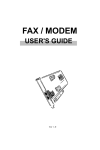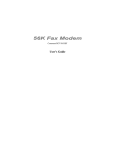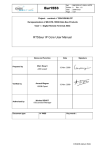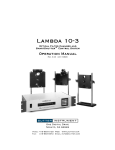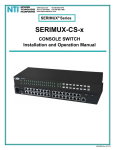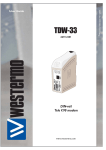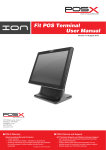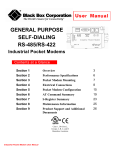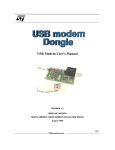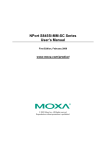Download HSF FAX/MODEM MANUAL
Transcript
HSF FAX / MODEM SoftSoft USER'S GUIDE Ver 1.0 CTR-21 Compliance Statement The equipment has been approved in accordance with Council Decision 98/482/EC for pan- European single terminal connection to the public switched telephone network (PSTN). However, due to differences between the individual PSTNs provided in different countries, the approval dose not, of itself, give an unconditional assurance of successful operation on every PSTN network termination point. In the event of problems, you should contact your equipment supplier in the first instace. F The manufacturer should ensure that the vendor and user of the equipment is clearly informed of the above information by means of packaging and /or user manuals or other forms of user instructions. The information in this document is subject to change without notice and does not represent a commitment on the part of the vendor. No warranty of representation, either expressed or implied, is made with respect to the quality, accuracy or fitness for any particular purpose of this document. The manufacturer reserves the right to make changes to the content of this document and/or the products associated with it at any time without obligation to notify any person or organisation of such changes. In no event will the manufacturer be liable for direct, indirect, special, incidental or consequential damages arising out of the use or inability to use this product or documentation, even if advised of the possibility of such damages. Microsoft Windows is a trademark of Microsoft Corporation. All product names are trademarks or registered trademarks of their respective owners. FCC Compliance Statement This device complies with Part 15 and 68 of the FCC Rules. Operation is subject to the following two conditions: 1. this device may not cause harmful interference, and 2. this device must accept any interference received, including interference that may cause undesired operation. FCC Warning Statement This equipment has been tested and found to comply with the limits for a Class B digital device, pursuant to Part 15 and 68 of the FCC Rules. These limits are designed to provide reasonable protection against harmful interference in a residential installation. This equipment generates, uses and can emit radio frequency energy and, if not installed or used in accordance with the instructions, may cause interference to radio communications. However, television reception interference can be determined by turning the equipment off and on, the user is encouraged to correct the interference by one or more of the following measures: • • • • Reorient or relocate the receiving antenna Increase the separation between the equipment and the receiver Connect the equipment into an outlet different from that to which the receiver is connected Consult the dealer or an experienced radio/TV technician for help. F Changes or modifications not expressly approved by the party responsible for compliance could void the user’s authority to operate the equipment The information contained in this manual has been verified at the time of this manual's printing. The manufacturer reserves the right to make any change and improvement in the product described in this manual at any time and without notice. All registered trademarks are the property of their respective owners.Copyright ©1999 All rights reserved. No reproduction of this document in any form is permitted without prior written authorization from the manufacturer. Version 1.0 Table of Contents Section One - Introduction 1 1.1 Modem Compatibility ......................................................... 1 Section Two - Installing The Modem 2 2.1 Unpacking Your Modem ..................................................... 2 2.2 Modem Installation ............................................................. 2 2.2.1 Hardware Installation .............................................. 2 2.2.2 Setting Up Modem Under Windows 98 .................. 3 2.2.3 Checking Modem Functionality .............................. 9 2.2.4 Uninstall Your Modem .......................................... 11 Section Three - Installing and Configuring Communication Software 12 3.1 Using Your Modem ........................................................... 12 3.2 Where To Go From Here .................................................. 12 Section Four - Troubleshooting Communication Software 14 4.1 Modem does not respond to commands. .......................... 14 4.2 Modem dials, but does not connect. ................................. 14 4.3 Modem makes a connection, but no data appears on your screen. ............................................................................... 14 4.4 Modem experiences errors while online with a remote modem. ............................................................................. 15 4.5 Modem exhibits poor voice record or playback. .............. 15 Section Five - AT Command Set 16 5.1 Executing Commands ....................................................... 16 5.2 Command Format ............................................................. 16 5.3 AT Commands .................................................................. 16 5.4 V.25ter AT commands ...................................................... 18 Section Six - S Register Summary 20 Section Seven - Result Code Summary 21 Section Eight - Specifications 22 1 Section One - Introduction Your new 56Kbps modem is a high speed PC communication peripheral that combines Data, Fax, Voice and Speakerphone functions into a single device. This high performance modem connects your computer to all popular modems and fax machines available today. This manual provides installation and operating instructions for your modem. Also included in this manual are listings and descriptions of the standard AT command set, S-registers, and troubleshooting tips. Be certain to read Section Two - Installing the Modem thoroughly before performing the actual installation. Our customer support experience has shown that many costly and time-consuming calls can be avoided with closer attention to the installation information provided here. 1.1 Modem Compatibility Your modem is compatible with the following standards: • V.90 (56Kbps down stream only) • K56 flex (56kbps download stream only) • V.34 (33600 bps) • V.32bis (14400 bps) • V.32 (9600 bps) • V.23 (1200/75 bps) • V.22bis (2400 bps) • V.22 (1200 bps) • V.21 (300 bps) • Bell 212A (1200 bps) • Bell 103 (300 bps) • V.17 (14400 bps FAX) • V.29 (9600 bps FAX) • V.27ter (4800 bps FAX) • V.21 Channel-2 (300 bps FAX) • V.42bis (data compression) • V.42 (error correction) • MNP 5 (data compression) • MNP 2-4 (error correction) • TIA/EIA 602 AT Command set • V.8 Start-up sequence • V.80(Video Ready mode) • V.8 bis Start-up sequence • Plug and Play PCI Spec. V1.0a • TIA/EIA 695 Voice command • TIA/EIA578 Class 1 Fax Command Set 2 Section Two - Installing The Modem This section explains how to connect your modem to your computer. 2.1 Unpacking Your Modem In addition to this manual, your modem package contains the following items: • One modem • Modem software & driver disc • manual include in Disc • One telephone cable NOTE: Contact your dealer if any of the above items are missing from your package. 2.2 Modem Installation The following steps provide instructions for installing your modem. 2.2.1 Hardware Installation CAUTION: Before removing the cover from your computer, turn off and unplug the computer and all attached peripherals. Discharge any static electricity from your body by touching any metal surface before removing the modem from its antistatic bag. 1. Turn off and unplug your computer from the AC outlet. 2. Remove the computer's cover according to its owner's manual. 3. Select any available PCI bus slot. 4. Remove the bracket and save the screw. 5. Carefully insert the modem into the selected slot. Apply even pressure until the modem is firmly seated. 6. Secure the bracket with the screw saved earlier. Store the bracket for future use. 3 7. Replace the computer cover and plug in your computer. Reconnect all cables. 1 2 4 3 5 7 * 6 8 0 9 8. Connect the telephone able into the modem's "LINE" connector (see Figure 2-1). Attach the other end into the telephone wall jack. This completes the internal modem installation. Figure 2-1 NOTE: The back of your modem should look like Figure 2-1. 2.2.2 Setting Up Modem Under Windows 98 This internal modem supports the Plug and Play feature. It allows your computer to set the optimal configuration for the modem and communication software automatically. PART A of the installation is for Windows 98. PART B of the installation is for Windows NT 4.0 . PART A (Windows 98) Please follow the procedure below to install the modem driver: 1. Turn ON computer power after completing hardware installation. 2. Windows 98 will automatically detect the Plug and Play modem and setup a "Conexant SoftK56 Data Fax RTAD PCI Modem" or "Conexant SoftK56 Data Fax Speakerphone PCI Modem" message under Add New Hardware Found as shown below. 4 Auto detect "PCI Communication Device" Click " Next" select "Search for the best driver for your device" Click "Next" Direct to CD-ROM (ex. F:\Drivers\W98) Click "Next" 5 search to "Conexant PCI Modem Enumerator" Click "Next" Click "Finish" 3. Select country (global version is necessary). Selecting a country other than the one in which you are currently located may cause your modem to be configured in a way that violates the telecommunication regulations/laws of that country. In addition, your modem may not function properly if the correct country selection is not made. Only select the country in which you are located. a. Click “Start” ⇒ “Settings” ⇒ “Control Panel” ⇒ “System". 6 b. Click "Country Select" Folder . Select Your Country or Region. PART B (Windows NT 4.0) Please follow the procedure below to install the modem driver: 1. Please click "Start " ⇒ "Run" 2. choose E:\Drivers\NT40\Setup.exe (E=CD-ROM driver letter) after put the installation CD-ROM into your drive. 7 Run "E:\Drivers\NT40\Setup.exe Click "OK" Click "Next" Search to "Conexant SoftK56 Data Fax RTAD PCI Modem" Click "Next" 8 Click "Finish" 3. Select country (global version is necessary). Selecting a country other than the one in which you are currently located may cause your modem to be configured in a way that violates the telecommunication regulations/laws of that country. In addition, your modem may not function properly if the correct country selection is not made. Only select the country in which you are located. a. Click “Start” ⇒ “Settings” ⇒ “Control Panel” ⇒ “HSF Modem Country Select". b. Select Your Country or Region. 9 2.2.3 Checking Modem Functionality 1. Start Windows 98 ⇒ Click “Start”⇒ "Settings” ⇒ “Control Panel” ⇒ “Modem”. 2. Click “General” and highlight "Conexant SoftK56 Data Fax RTAD PCI Modem" as shown below. 10 3. Click "Diagnostic" and highlight the designated COM as shown below. Click “More Info ...” and the system will communicate with the modem. Click "OK" 11 2.2.4 Uninstall Your Modem PART A (Windows 98) 1.Click “Start” ⇒ “Settings” ⇒ “Control Panel” ⇒ “Add/Remove Programs" . 2.. highlight "Conexant SoftK56 Modem" 3. click "Add/ Remove" and "OK" to remove the modem. PART B(Windows NT 4.0) 1.Click “Start” ⇒ “Settings” ⇒ “Control Panel” ⇒ “Add/Remove Programs" . 2. highlight "Conexant SoftK56 PCI Modem(Uninstall)" 3. click "Add/ Remove" and "OK" to remove the modem. 12 Section Three - Installing and Configuring Communication Software NOTE: Install the communication software according to the software user's manual. Be certain that your software is configured to communicate with the modem on the same COM port and IRQ line used by the modem. You may be prompted by the software to configure certain communication parameters. We suggest the following settings: Baud rate: 57,600 bps Data bits: 8 Parity: None Stop bit: 1 Flow Control: RTS/CTS Initialization string: AT&F The AT commands used by the modem are compatible with the command set used by Intel modems. Select a Rockwell modem type if prompted by your data communications software. Select Generic Class 1 or Rockwell modem type when prompted by your Fax or Voice software. 3.1 Using Your Modem Common modem functions (i.e. dialing, file transfer, faxing) are performed by using communication software in conjunction with the modem. NOTE: The communication software included with your modem provides a user friendly interface for all common modem functions and should be sufficient for all of your communication needs. 3.2 Where To Go From Here If you have difficulties getting your modem to work, read Section Four to find information as well as answers to commonly asked questions and problems concerning the communication software. Sections Five through Ten contain reference material (AT commands, S-register, and Result-codes, etc.) and can be skipped. NOTE: It is important that you familiarize yourself with the functions available from the included software by 13 reading its manual (you may also use any other commercially available communication software). The software manual includes detailed information on all common modem functions. 14 Section Four - Troubleshooting Communication Software Your modem is designed to provide reliable and trouble-free service. Should you experience any difficulty, however, the information contained in this section will assist you in determining and resolving the source of the difficulty. If you cannot resolve your difficulty after reading this chapter, contact your dealer or vendor for assistance. 4.1 Modem does not respond to commands. 1. Make sure the modem is not configured with a conflicting COM port and IRQ setting . If another device in your system is also configured as the same COM port, it will not work. Similarly, IRQ settings may not overlap. 2. Make sure the communication software is configured with the correct COM and IRQ settings (same COM port and IRQ line as the modem). Your communication software will not be able to send-to and receivefrom your modem any data if it does not have the correct COM and IRQ settings of the modem. 3. Make sure the modem is properly initialized by the communication software. Your modem may have been improperly initialized by the software because you have selected an incorrect modem type. Select "Rockwell" modem type in your data communication software (select "Generic class 1" and "Rockwell" in your Fax software, respectively). You may also be prompted to enter an initialization string by the software. Use AT&F as your initialization string. 4.2 Modem dials, but does not connect. 1. Make sure the COM port setting is identical on both the system AND the software. 2. Make sure the phone line is working properly. A noisy line will prevent proper modem operation. 4.3 Modem makes a connection, but no data appears on your screen. 1. Make sure all communication parameters (baud rate, data, stop, and parity bits) are properly configured and identical on both sides. Be certain hardware flow control (RTS/CTS - default) is enabled in both the 15 modem and the communication software. 2. Press the ENTER key several times. The remote system may be waiting to receive your data before it begins. 3. Make sure the correct terminal emulation mode is being used in the software (refer to software manual). 4.4 Modem experiences errors while online with a remote modem. 1. Make sure Call Waiting is turned off. 2. Make sure RTS/CTS hardware flow control is enabled. Do not use XON/XOFF software flow control when transferring binary 3. Make sure the data speed is not faster than your computer's capability. Operating at higher speeds under Windows 95 requires a faster CPU (Pentium 200MHz or better). 4.5 Modem exhibits poor voice record or playback. 1. Make sure the correct modem type is selected in the Voice/Fax software. Use "Rockwell" or similar selection. Do not select "Cirrus Logic" or "Lucent". 2. Make sure your computer is fast enough to handle voice operations (38.4Kbps). Voice operations are CPU intensive and require a Pentium 200MHz or better CPU when running under MS Windows 95. 16 Section Five - AT Command Set 5.1 Executing Commands Your modem is in Command Mode upon power-on and is ready to receive and execute “AT” commands. The modem remains in Command Mode until it makes a connection with a remote modem. Commands may be sent to the modem from an attached terminal or a PC running a communication program. This modem is designed to operate at common DTE speeds ranging from 115.2Kbps (or 57.6Kbps) to 300bps. All commands and data must be issued to the modem using one of the valid DTE speeds. 5.2 Command Format All commands must begin with the AT prefix, followed by the command letter and ended with the ENTER key. Spaces are allowed in the command string to increase command line readability, but are ignored by the modem during command execution. All commands may be typed in either upper or lower case, but not mixed. A command issued without any parameters is considered as specifying the same command with a parameter of “0”. Example: ATL[ENTER] This command causes your modem to lower its speaker volume. 5.3 AT Commands All default settings are printed in bold text. Command Function A A/ Dn Answer incoming call Repeat Last command. Do not preceed A/ with 0 - 9, A-D, # and * L Redial last number P Pulse dial T Tone dial W Wait fo second dial tone , Pause @ wait for 5 seconds of silence ! flash ; return to command mode after dialing & wait for AT&T bong tone Command echo disabled Command echo enabled E0 E1 17 +++ H0 H1 In L0 L1 L2 L3 M0 M1 M2 M3 O0 O1 P Q0 Q1 Sr? Sr=n T V0 V1 X0 X1 X2 X3 X4 Z &C0 &C1 &D0 &D1 &D2 &F &G0 &G1 &G2 &P0 Escape characters - switch from Data Mode to Command Mode Modem on-hook (hang-up) Modem off-hook (make busy) Report Identification information (n=0-7) Speaker OFF Low speaker volume Medium speaker volume High speaker volume Speaker always off Speaker on until carrier detected Speaker always on Speaker off during dialing, on until carrier detected Return to Data Mode Initiate a retrain and return to Data Mode Pulse dial Result code enabled Result code disabled Read S-register r. Refer to Chapter 7 for details Set S-register r to value n. Refer to Chapter 7 for details Tone dial Numeric responses Text responses Enables CONNECT result code only. Dial tone and busy detection are disabled Same as X0 plus all CONNECT responses/blind dialing EnablesallCONNECT<speed> resultcode.Dialtone detectionis enabled, but busy detection is disabled Enables all CONNECT <speed> result code. Dial tone detection is disabled. but busy detection is enabled EnablesallCONNECT <speed> result code. Dial tone and busy detection are both enabled Reset and recall configuration profile Carrier detect always ON Turn on CD when remote carrier is present DTR signal ignored Modem return to Command Mode after DTR toggle Modem hangs up and return to Command Mode after DTR toggle Loadfactorydefault configuration profile Guard tone disabled Guard tone disabled 1800Hz guard tone enabled Set pulse dial to 39%/61% make/break 18 &P1 &P2 &P3 &V &W %E0 %E1 %L %Q ratio @ 10 pps Set pulse dial to 33%/67% make/break ratio @ 10 pps Set pulse dial to 39%/61% make/break ratio @ 20 pps Set pulse dial to 33%/67% make/break ratio @ 20 pps Report current configuration and stored profile Store current configuration Line quality monitor disabled Line quality monitor enabled Display line signal level Dispaly line signal quality 5.4 V.25ter AT commands Command +GMI +GMM +GMR +GSN +GOI +GCAP +IFC=a,b +ILRR=0 +ILRR=1 +MS=a,b,c,d,e,f Function Report manufacturer ID Report model ID Report revision ID Report product serial number ID Report global object ID Report complete capability list Set DTE-modem local flow control Parameter a specifies the local flow control from modem to DTE,where 0=Disabled 1=Enables XON/XOFF 2=Enables RTS Parameter b specifies the local flow control from DTE to modem, where 0=Disabled 1=Enables XON/XOFF 2=Enables CTS The default is +IFC=2,2 Localportrate reporting disabled local port rate reporting enabled Select Modulation Parameter a specifies the modulation protocol as B103, B212, V21, V22, V22B, V23C, V32, V32B, V34 or K56FLEX,V90 Parameter b specifies automodeoperation, where0=autoode disabled, 1=automode enabled. Parameter c specifies the lowest transmit speed for connection. Parameter d specifies the highest transmit speed 19 +MR=0 +MR=1 +ES=a,b,c +ER=0 +ER=1 +DS=a,b,c,d for connection. Parameter e specifies the lowest receive speed for connection. Parameter f specifies the highest receive speed for connection. The default is +MS= K56, 1, 75,33600,75,56000 Modulation connection reporting disabled Modulation connection reporting enabled Select error control and synchronous access mode Parameter a specifies the initial requested mode when modem originates a call, where 0=initiate call with direct mode 1=initiate call with normal mode 2=initiate call with V.42 without detection phase 3=initiate call with V.42 withdetection phase 4=initiate call with MNP mode 6=initiate call with V.80 synchronous access mode Parameter b specifies the acceptable fallback mode when modem originates a call, where 0=LAPM,MNP or normal mode 2=LAPM or MNP mode 3=LAPM mode only 4=MNP mode only Parameter c specifies the acceptable fallback mode when modem answers a call or specifies V.80 synchrounous access mode where 1=Normal mode 2=LAPM,MNP or normal mode 4=LAPM or MNP mode 5=LAPM mode only 6=MNP mode only 8=answer call with V.80 synchronous access mode The default is +ES=3,0,2 Error control reporting disabled Error control reporting enabled Select data compression parameter Parameter a specifies the desired direction of data compression, where 0=data compression disabled 1=both direction data compression enabled Parameter b specifies whether or not the modem whether or not the modem should continue to operate if the result is not obtained, where 0=don't disconnect Parameter c specifies the maximum number of dictionary entries. 20 Section Six - S Register Summary Your modem has 16 registers, designated S0 through S89. Table 6-1 shows the registers, their functions, and their default values. Some registers can have their values changed by commands. If you use a command to change a register value, the command remains in effect until you turn off or reset your modem. Your modem then reverts to the operating characteristics specified in its nonvolatile memory. Refer to Section Five for information on how to use the AT commands to manipulate the S registers. NOTE: The default value and range of some S-registers listed below could vary with country. Table 6-1 S - Registers Register Function Range/units Default S0 Auto-answer Ring 0-255 /rings 0 S1 Ring counter 0-255 /rings 0 S2 Escape code character 0-255 /ASCII 43 S3 Carriage return character 0-127 /ASCII 13 S4 Line feed character 0-127 /ASCII 10 S5 Backspace character 0-32,127 /ASCII 8 S6 Dial tone wait time 2-255 /seconds 2 S7 Remote carrier wait time 1-255 /seconds 50 S8 Comma pause time 0-255 /seconds 2 S10 Carrier loss time 1-255/0.1 second S11 Touch-tone dialing speed 50-255 /milliseconds 95 S12 Escape character guard time 0-255 /0.02 second 50 14 21 Section Seven - Result Code Summary OK 0 CONNECT 1 RING 2 NOCARRIER 3 ERROR 4 CONNECT1200E 5 NODIALTONE 6 BUSY 7 NOANSWER 8 CONNECTxxxxx* 10 DELAYED 24 BLACKLISTED 32 FAX 33 DATA 35 +FCERROR +F4 NOTE: For x1, x2 , x3 and x4 the modem send this result code when the DTE speed is xxxxx bps 22 Section Eight - Specifications Modulation std.: V.90, K56flex, ,V.34, V.32bis, V.32, V.29, V.27ter, V. 22bis,V.23, V.22, V.21, V.17, Bell 212/103, Compression: V.42bis, MNP Class 5 Error Correction: V.42, MNP Classes 2-4 FAX Command: TIA/EIA 578 class 1 Transmit level: -12 dBm +/- 1 dB (vary with country) Sensitivity: -43 dBm UART: 16550 compatible Power: .75 W max Temperature: 0 to 55 degrees C, operating; -20 to 80 degrees C, non-operating





























